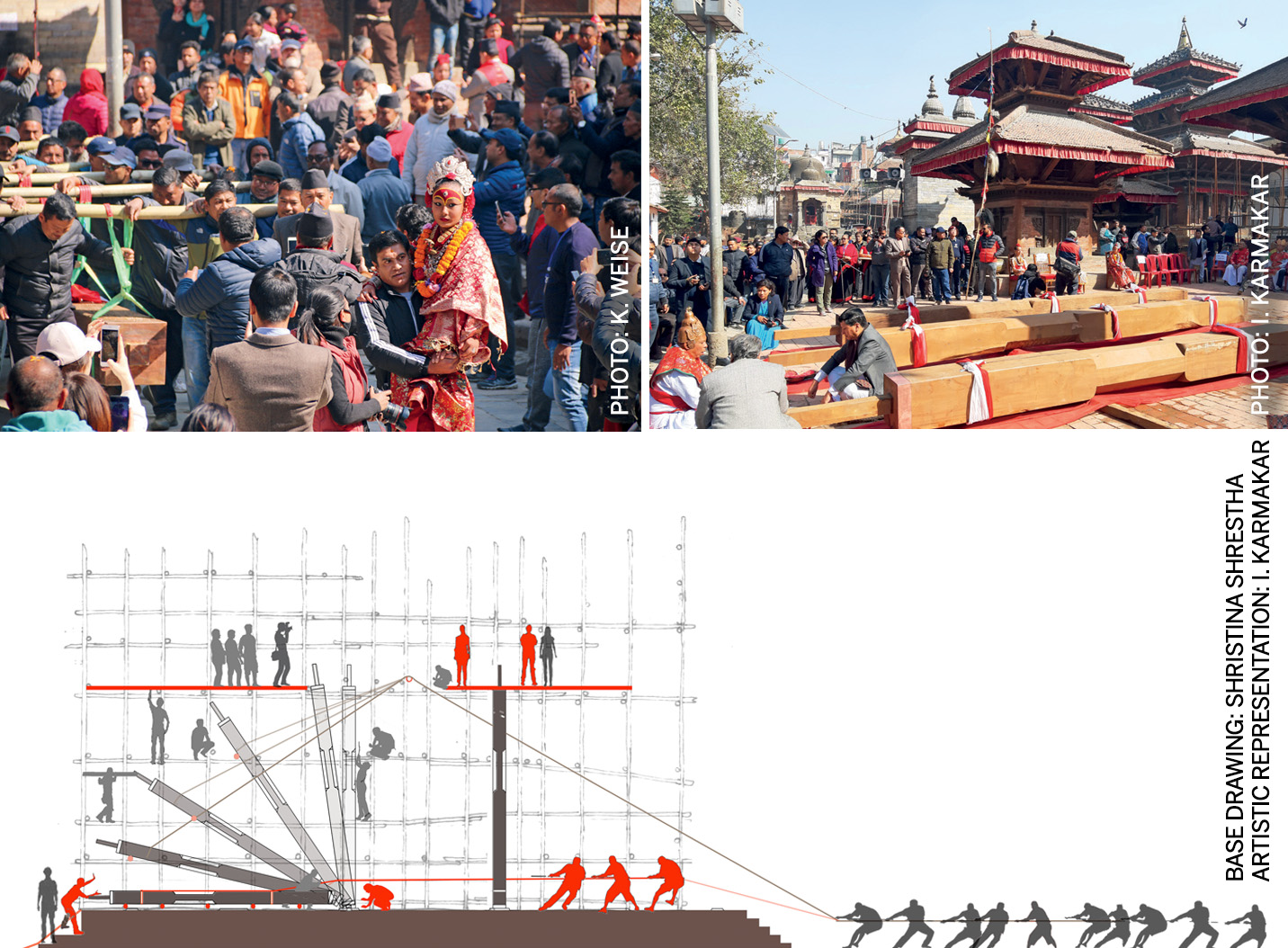Very often, in the case of South Asian countries like India and Nepal, religious structures are the epicentres around which community life revolves. There is a sense of collective ownership for these structures and they become icons of community pride, heritage and identity. But what happens when such an icon is destroyed and how do communities rally behind the rebuilding of such structures?

Second : Kasthamandap after the earthquake of 2015
Third: Restoration section of Kasthamandap
Bottom: Panch Daan ritual, (2019)
Kasthamandap
Kasthamandap, translating literally to ‘wooden pavilion’, is considered to be the oldest structure in Kathmandu and the city derives its name from it. The post-earthquake archaeological research revealed evidence of the structure dating back to the 7th century. For the indigenous Newar community in Kathmandu, the Kasthamandap symbolised more than a historic structure, rather a manifestation of their cultural identity. The Kasthamandap originally designed as a ‘sattal’ (rest house) for travellers, has changed its function over the centuries (Weise, 2006). It was also used as an assembly hall by the royal court and later with the establishment of the Gorakhnath statue, the Nath cult community started living there, during which time several modifications to the structure were made (Risal, 2015). In the ’70s, it became a haven for the global hippie movement. Despite the changing nature of this structure, various religious rituals that were performed on its premises every year have continued.
On the afternoon of 25th April 2015, an earthquake of magnitude 7.8 on the Richter scale struck the valley of Kathmandu, flattening it and leading to the collapse of several heritage buildings. Among them was the Kasthamandap; the entire superstructure collapsed leaving only the plinth of the historic monument. The foundations were severely damaged in the rescue operations and for at least three years, the Kasthamandap ruins remained under lock and key.
The reigns of the reconstruction were given to the Kathmandu Metropolitan City authority of the Government of Nepal. However, cultural heritage in Kathmandu has traditionally been handled by community-based socio-religious groups called ‘Guthis’ (Weise, 2006). The care of each temple, its upkeep and donation to its activities has been undertaken through these caste-based institutions with no external help. Coupled with the unstable political climate of the new democracy of Nepal, community members were reluctant to hand over the responsibility of reconstruction to government authorities. In the light of this situation, Kasthamandap reconstruction remained in dispute for three years and was only kick-started when a unique ‘government-aided, community based’ reconstruction committee was instituted for its rebuilding.
There is a sense of collective ownership for these structures and they become icons of community pride
Miffed at earlier suggestions for structural retrofitting of the foundations with concrete piles, the committee took the decision to rebuild the entire structure with the help of strictly traditional methods (Bhattarai, 2018). They argued that the value of cultural heritage in Nepal was not only symbolised by the physical, tangible structure, but by the continuity of traditional building practices involving the traditional craftsmanship of artisans and masons. In fact, traditional structures were designed with the principle of ‘cyclical renewal’; the wood would rot in a few years and the buildings were designed such that a few elements could be removed and replaced without dismantling the entire structure (Government of Nepal, 2017). What led to the collapse of the historic structures during the earthquake had more to do with the eroding of such traditional practices, lack of maintenance and nationalisation of ‘Guthis’ (Al Jazeera, 2019).
For the residents of Kathmandu Darbar Square, where Kasthamandap is located, religious activities after the earthquake continued even without the physical manifestation of the structures themselves. The Panch Daan, a ritual of cooking rice on the ground floor of Kasthamandap as an ordering to priests continued right amidst the rubble, with construction workers and their wheel barrows milling around the priests. It was not unusual to see poojas being performed to the lock on the fence guarding the premises and the country’s several jatras (processions) continued over the years, the chariots stopping reverentially before the pile of rubble that was Kasthamandap. In fact, the structure had become a modern day ‘Ship of Theseus’, the legendary Greek ship, that posed the conundrum of what actually the ship was, an idea or the amalgam of its materials? Kasthamandap did not need to exist physically to exert its importance, but as the reconstruction commenced, the act of rebuilding became an act of worship for its community.

Top Right: The ritual for the consecration of the Kasthamandap column
Bottom: Artistic representation of the column hoisting
Rebuilding Kasthamandap
Throughout the process of rebuilding, a delicate balance had to be struck between the voices of all stakeholders: the structural engineers, historians, conservation architects, masons, artisans and community elders. On the one hand, structural engineers conducted load calculations for a primarily load bearing, brick and mud mortar structure and on the other hand historians pored over the mandala design of the structure and its alignment with the tenets of Buddhism and Hinduism. Kasthamandap was a living heritage site and every modification to its structure had to be socially acceptable. The construction site was open and every step of the onsite work was preceded by a pooja and a feast. In Feburary 2019, the almost seven-metre tall central columns of Kasthamandap were hoisted with the help of volunteers of the Newar community, who refused the use of cranes for the task. They saw it as an example of a community building exercise and a contribution of each individual to the task of rebuilding their national pride.
Traditional structures were designed with the principle of ‘cyclical renewal’
Reconstruction Process
The process of rebuilding meant conducting experiments with traditional construction materials for their structural properties as well as their availability in modern times. Sample cubes made of varying proportions of clay and mud, mortar and brick were subjected to a shake table test, to tabulate the structural properties of traditional materials with regards to seismic safety. Though Kasthamandap was said to be carved from a single tree, it became difficult to comply with the mythology and a compromise was made to reconstruct it with multiple sal trees. The building was constructed keeping in mind traditional practices mostly aided by technology and structural logistics, balancing both myth perpetuation and the science of building.
In the process of this reconstruction, Newar artisans with years of experience working with timber and on heritage structures, hand carved hundreds of exquisite carvings on brackets and columns. The trade had continued through generations among these Newar artisan families and the earthquake had, in a cruel twist of fate, provided an impetus to revive these woodcarving traditions. One of the major decisions taken in the rebuilding process was to salvage as many of the wooden structural elements as possible and reuse them once they were declared fit for reuse after damage and structural mapping.

Bottom Left: Pairing together of salvaged central brackets of the Kasthamandap
Bottom Right: Kasthamandap (June 2019)
This brought along an added challenge in the reconstruction effort: to determine the exact dimensions and placement of elements such as brackets, railings and columns. Each element has a significance in the larger placement, whether ritualistic or historic. In one instance, when overlapping salvaged central brackets had to be placed together in pairs, it was di.cult to determine which two brackets had originally been paired together before the collapse of the Kasthamandap. It was the artisans’ experience that saved the day; they suggested that we look for numerical scratched markings on the wood that perhaps the 7th century carvers had left on them, who in turn must have predicted the quandary that such an operation would put future rebuilders in. And inadvertently, the process of pairing the brackets followed smoothly, once we followed the line of breadcrumbs that masters several centuries earlier had laid.
This idea of cyclical rebuilding makes sense when we consider that earthquakes are known to strike Nepal every 80-100 years. What is built will eventually have to be rebuilt when it collapses several centuries later. In the architects’ contribution towards this trail of breadcrumbs that started several centuries earlier, we left a layer of yellow mortar in between the untouched, original foundation of the Kasthamandap and the superstructure that was to be reconstructed. This was done in order to distinguish the historic layers of the structure for future architects and researchers down the line to refer to.
Each element has a significance in the larger placement, whether ritualistic or historic
Building Resilience
Heritage reconstruction has several faces and it starts to question what it means to truly ‘preserve’ a building. In Japan, the Ise Jingu grand shrine in the Mie prefecture is torn down every 20 years, to be built anew (Nuwer, 2013). This tradition makes sure that traditional building skills are passed down to the next generation and rebuilding the temple keeps it eternally alive. This argument was used repeatedly in the context of the Kasthamandap. The idea was to rebuild the Kasthamandap so that it survives a major disaster, but the building is continuously repaired and rebuilt in parts, to ensure its continuity.
Today, the ground floor timber work of the Kasthamandap has reached its finishing stages. The entire construction is presumed to end in 2021, and the world awaits with bated breath a unique experiment in community-based historic conservation.
The author worked with the Himalayan Consulting Architects and Engineers for a year in 2018. She was involved in the process of reconstruction of the Kasthamandap in the capacity of an architect, assisting Ar. Anie Joshi and Ar. Kai Weise.



Comments (0)